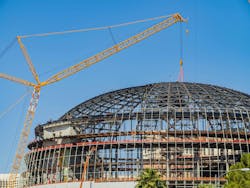Precision Meets Process: MBSE and Laser Metrology Aid in Complex Assembly
Key Highlights:
- Van Horn, whose resume includes engineering efforts on the Madison Square Garden Sphere in Las Vegas, discusses how combining MBSE with laser metrology improves accuracy from design to installation.
- Real-time laser tracking and dense point cloud data enable precise fit-up, eliminating reaming and preserving structural integrity during heavy equipment assembly.
- Incorporating thermal expansion models into digital twins allows for optimized scheduling and design adjustments, mitigating environmental impacts on assembly accuracy.
Enjoying Machine Design’s Industrial Equipment & Heavy Machinery content? Be sure to check out the rest of our Takeover Week coverage here.
Complex assembly and precision engineering have always challenged multidisciplinary design teams, especially in sectors like heavy equipment manufacturing where tolerance management, environmental variability and distributed fabrication sites add layers of difficulty.
The experience of industry veteran Jeff Van Horn, who has led engineering and metrology efforts on landmark projects such as the Madison Square Garden Sphere in Las Vegas and NASA’s Artemis launchpad, illustrates how model-based systems engineering (MBSE) combined with advanced laser metrology improves accuracy, efficiency and safety from design through installation.
By drawing parallels to these projects that demanded extreme accuracy under dynamic conditions, we can explore how MBSE and advanced laser metrology can deliver similar gains in efficiency, safety and build integrity for heavy equipment operations.
Integrating Metrology with MBSE
Machine Design had the opportunity to catch up with Van Horn this past June at Hexagon Live in Las Vegas. “We’re an engineering company that got into metrology because we just needed better information,” he said.
His team at Industrial Technology Solutions Inc., which includes both of his sons (also mechanical engineers), relies on several pieces of equipment to capture accurate measurement data. These include Leica ATS600 laser trackers, Leica Absolute Arms and Hexagon total stations with B-Probe Plus scanners to capture spatial data with sub-millimeter accuracy.
Van Horn says these devices enable the production of dense point clouds and precise measurement data without requiring facility shutdowns, crucial for “where it's $1 million an hour in revenue loss during downtime,” he said.
This rich metrology data feeds directly into MBSE workflows by providing a detailed spatial reference frame to compare as-built components to their as-designed CAD models. The digital integration of metrology CAD assisted solutions (MCAS) happens across platforms such as Tekla Structures, PolyWorks and Hexagon Spatial Analyzer , with data standardized into STEP formats for multi-facility interoperability, he explained.
Controlling Tolerances, Eliminating Reaming, Improving Build Integrity
A traditional challenge often encountered in heavy equipment assembly is bolt-hole misalignment, which results in on-site reaming material removal to force bolt fits. This weakens joints and increases labor. Van Horn explains: “When steel erectors pull things into place, they pin them…if you can't fully pin it, you have to ream it in order to get bolts in…when you're reaming, you're losing material.”
In the Sphere project alone, which is composed of more than 7,700 carefully placed brackets, the team successfully maintained joint tolerances so precisely that “not a single reamer was used on this project, not one single reamer,” Van Horn said.
Laser trackers combined with real-time feedback to fitters eliminated trial-and-error fits, reduced manual physical effort (which Van Horn said is particularly important when crews work at height) and preserve structural integrity. Such precision is also essential for heavy machinery subjected to dynamic loads and vibration where joint failures can have costly or dangerous consequences.
Managing Environmental Effects: Thermal Expansion and Digital Twins
The influence of temperature on material dimensions can disrupt assembly accuracy significantly. Van Horn recounts that every time the sun came up, the geosphere would grow toward the sun an inch and a half to two inches—"as the sun rotated, so did the geosphere,” he said. To address this, the team incorporated thermal behavior into their digital twins by integrating material thermal expansion coefficients with ambient temperature profiles spanning fabrication transport and assembly phases. He said this allowed for several things:
- Scheduling lifts and assembly operations during periods where steel contraction minimized dimensional discrepancies (such as 2 a.m. crane lifts)
- Heat treatment processes to correct dimensional warpage before physical assembly Dynamic modeling to predict tension on critical structural tubes, preventing overstress conditions.
In heavy equipment applications, similar approaches enable predictive simulation of operational dimensional changes—supporting designs resilient to temperature variations and reducing maintenance risks related to thermal stresses.
Coordination Across Geographically Distributed Fabrication
The Sphere’s construction involved components fabricated in Colorado, Texas, Oklahoma and Arkansas, along with on-site assembly in Nevada. This dispersion complicated quality control and assembly due to transport-induced distortions and inconsistent fabrication processes.
Van Horn said a centralized data repository exchanging standardized STEP files allowed continuous cross-site verification and model updating. Laser scans captured as-built geometry at each fabrication site and on-site, feeding back into the MBSE environment and enabling timely troubleshooting. Crew training—ensuring fitters and welders could interpret measurement results effectively—was necessary for consistent execution and quality, he said.
Precision Assembly for Aerospace Infrastructure
Van Horn's work on the Artemis launchpad (the Mobile Launcher 2 [ML-2] and subsequent modules) extend the application of MBSE and metrology into aerospace infrastructure, requiring even tighter tolerances and environmental controls.
The Artemis modules consist of cast steel connect nodes similar to those used on the MSG Sphere project but requiring even stricter flatness and alignment tolerances. The flange flatness on Artemis components was controlled within 1/32 of an inch to ensure tight assembly fit and structural integrity necessary for launch loads.
“We absolutely didn’t give 1/32 of an inch [tolerance], because that one needed to be shimmed, or we had to machine,” Van Horn noted. Welding-induced flange cupping required in-place machining to restore flatness, applying lessons from field scanning and digital model feedback.
Thermal modelling was incorporated into assembly planning to anticipate dimensional changes during fabrication, transport and launchpad erection. The Artemis team used simulations, including material properties and operational temperature profiles to optimize fit-up scheduling and sequence work to avoid overstressing components, he said.
Virtual Assembly from Digital Models to Field Operations
For both high-profile engineering marvels, Van Horn's team routinely merged captured point cloud data with CAD models to perform virtual assembly fit verification, identifying potential clashes or misalignments prior to erection. This process enabled dramatic reductions in on-site assembly time.
Referencing the Sphere: “Most of the time, we’d have the ATS600 set right in the center…the initial immersive that was done on the sides took a week to place one whole section; within two weeks, we had it down to one flying every day,” Van Horn said.
Such digital verification allows assembly teams to work with realistic measured conditions rather than theoretical designs, which significantly improves fit-up accuracy and reduces rework. This practice translates directly to complex heavy machinery assemblies where multiple subsystems and supplier inputs must align perfectly.
Van Horn's real-world insights inform several practical strategies for machinery and heavy equipment teams, including:
- High-resolution pre-assembly scanning. Validate dimensional accuracy of parts and subassemblies before shipment to prevent costly on-site adjustments.
- Stringent tolerance enforcement. Maintain tight joint and bolt hole tolerances, reducing the need for physical intervention and safeguarding structural integrity.
- Thermal behavior integration. Incorporate environmental and operational temperature effects into design and assembly models for improved reliability.
- Cross-site data standardization. Use standardized CAD and metrology file formats to foster interoperability among multiple fabrication partners
- Comprehensive training. Equip field teams with the knowledge to utilize digital measurement feedback effectively ensuring assembly matches design intent.
About the Author
Sharon Spielman
Technical Editor, Machine Design
As Machine Design’s technical editor, Sharon Spielman produces content for the brand’s focus audience—design and multidisciplinary engineers. Her beat includes 3D printing/CAD; mechanical and motion systems, with an emphasis on pneumatics and linear motion; automation; robotics; and CNC machining.
Spielman has more than three decades of experience as a writer and editor for a range of B2B brands, including those that cover machine design; electrical design and manufacturing; interconnection technology; food and beverage manufacturing; process heating and cooling; finishing; and package converting.
Email: [email protected]
LinkedIn: @sharonspielman
Facebook: Machine Design
YouTube: @MachineDesign-EBM



